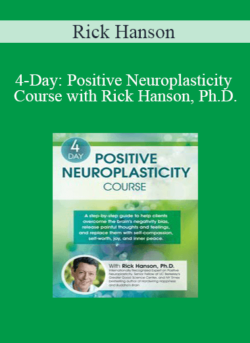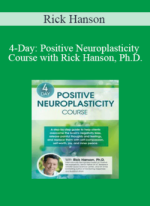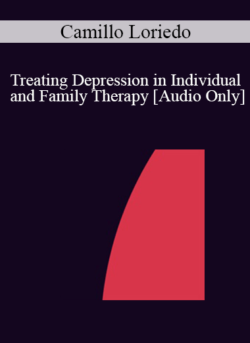[Instant Download] – Immediately deliver the download link after receiving the paymentPurchase Rick Hanson – 4-Day: Positive Neuroplasticity Course with Rick Hanson, Ph.D. courses at here with PRICE $699.99 $132Faculty:Rick HansonDuration:24 Hours 12 MinutesFormat:Audio and VideoCopyright:Oct 21, 2019 Manual – 4-Day Positive Neuroplasticity Certificate Course (12.8 MB) 145 Pages Available after Purchase OutlineTHE ESSENCE OF POSITIVE NEUROPLASTICITY: FUNDAMENTALS OF POSITIVE BRAIN CHANGE AND HOW TO MEET YOUR CLIENTS’ CHALLENGES BY HELPING THEM GROW DURABLE PSYCHOLOGICAL RESOURCESThe critical role of psychological resources to deal with clients’ challenges and vulnerabilities The stress-diathesis model: Challenges, vulnerabilities, resourcesResources located in world, body and mindThe special opportunity and value of mental resourcesOverview of mental resources (i.e., psychological resources) that are clinically relevantWhy most of our mental resources are learned: acquired, not innateThe necessary two stage process of any learning, including acquiring all mental resources: activation and installationWhy experiencing doesn’t equal learningWhy most therapeutic experiences do not have lasting valueActivity: Help clients identify significant challenges and vulnerabilities, and then identify relevant psychological resources for theseThe Neuropsychology of Learning The brain’s evolved negativity biasClinical implications of the low conversion of therapeutic experiences to lasting changes of neural structure and functionMajor mechanisms of experience-dependent neuroplasticityWhat is positive neuroplasticityActivity: Discussion about the clinical implications of the negativity biasActivity: Explain the negativity bias to a clientClients as Active Learners Environmental, behavioral and mental factors that increase learning, and thus the acquisition of psychological resourcesThe special opportunity and value of mental factors of learningEmpower clients to be active agents in their healing and growingTwo kinds of mental factors: Contextual and engagementThe opportunity and value of engagement factorsClinical benefits of clients actively engaging the experiences they are having to steepen their learning/healing/grown curvesActivity: Experience the two-stage process of learning while using engagement factorsActivity Explain the two-stage process of learning to a client, and then describe engagement-type mental factors of learningThe Three Ways to Engage the Mind Productively Letting go – observing, accepting, exploring the contents of consciousnessLetting go – preventing, decreasing, or releasing negative or traumatic materialLetting go – creating, sustaining, or increasing positive materialsWhat is mindfulness; why mindfulness is part of letting go and letting inHow letting be, letting go, and letting in form a natural healing sequenceActivity: Experience the three ways to engage the mindActivity: Explain the three ways to engage the mind to a clientActivity: Practice the three ways to engage the mindTeaching Positive Neuroplasticity to Clients The science of positive neuroplasticityHow to guide clients through experiential practicesIdentify and work through key blocks to having and internalizing beneficial experiences, such as distractibility, fear, shame, anxiety, social expectations and traumaActivity: How to explain positive neuroplasticity to a clientHAVING, ENRICHING, AND ABSORBING EXPERIENCES: HOW TO MAKE THE MOST OF THE POSITIVE EXPERIENCES CLIENTS ARE ALREADY HAVING, TURNING PASSING STATES INTO LASTING TRAITS Overview of the HEAL Framework of Engagement Factors of Learning Have a beneficial experienceEnrich it – increasing the neural activity underlying an experienceAbsorb it – increasing the sensitivity of the memory-making mechanisms of the brainLink positive and negative materialsActivity: Experience the HEAL processActivity: How to explain the HEAL process to a clientHaving Beneficial Experiences Notice beneficial experiences in the foreground and background of awarenessCreate beneficial experiences; overview of many ways to do thisThe five elements of an experience: Thoughts, perceptions, emotions, desires, actions; why each is an opportunity for acquiring an aspect of a psychological resourceDeal with “yes, but” and other blocks to clients having beneficial experiencesActivity: Experience the five elements present in an experience of playfulnessActivity: Guide a colleague to be aware of the five elements present in an important experienceEnriching Experiences to Increase Their Neural Registration Five factors of Enriching: Duration, intensity, embodiment, novelty, salienceActivity: These three factors applied to an experience of a psychological resourceActivity: Explain these three factors to a clientActivity Guide a colleague through using these three factors of Absorbing to deepen the internalization of an experience of psychological resourceLINKING POSITIVE AND NEGATIVE MATERIALS: USE POSITIVE MATERIALS TO SOOTHE, CONTEXTUALIZE, AND REPLACE NEGATIVE MATERIALSOverview of Linking Positive and Negative Material Implicit and explicit memoryHow negative material is consolidated, activated, and reconsolidated in the brainThe window of time during which the reconsolidation of negative material can be disruptedThree ways to manage negative material: Grow relevant psychological resources, associate positive to negative, disrupt the reconsolidation of the negativeSelf-compassion: A key resource for managing negative material, and an example of LinkingActivity: Experience the Link stepActivity: Explain the Link step to a clientActivity: Guide a colleague through the Link stepDiscussion and Application of Material Presented Four ways to use positive neuroplasticity and the HEAL framework with clientsAdapt positive neuroplasticity for childrenActivity: Discussion with a colleague about using positive neuroplasticity and the HEAL framework with one or more challenging clientsActivity: How to explain the Link step to a clientActivity: Guide a client through the Link stepKEY PSYCHOLOGICAL RESOURCES: HOW TO IDENTIFY SPECIFIC PSYCHOLOGICAL RESOURCES THAT ARE MATCHED TO CLIENTS’ PSYCHOLOCIAL ISSUES Our Three Needs and Two Ways of Meeting Them The three fundamental needs of any animal, including humans: Safety, satisfaction, connectionThe meeting of these needs through Avoiding harms, Approaching rewards, and Attaching to othersSocial brain theoryWhy there is more to human life avoiding pain and approaching pleasureThe reptilian, mammalian, and primate/human stages of brain evolution and their relationship to the Avoiding, Approaching, and Attaching systemsOur basic two ways of meeting needs: The Responsive and Reactive modes, without stress and with stressExplain what it means when clients go to Responsive mode and Reactive mode and the impact of eachActivity: Discussion with a colleague about these three needs and two modes for meeting themIdentifying Key Psychological Resources Matched to Clients’ Needs Demonstration by instructor with a volunteer of identifying key resourcesOverview of resources for safety, satisfaction & connectionThe value in repeatedly internalizing experiences of needs sufficiently metThe metaphors of repeatedly petting the lizard, feeding the mouse, and hugging the monkeyActivity: Guide a colleague to identify key resources for an issueActivity: Experience of a basic sense of safety, satisfaction, and connection: peace, contentment, and loveHelping Clients to Identify and Internalize Key Psychological Resources Demonstrate by instructor with a volunteer of identifying and internalizing one or more key resources, using the HEAL frameworkDiscussion of what helped this go wellActivity: Guide a colleague to identify and internalize one or more key resources, using the HEAL frameworkGROWING STRENGTHS FOR SAFETY: ESTABLISH A FOUNDATION OF CALM AND SAFETY IN WHICH CLIENTS CAN GAIN THE CONFIDENCE THEY NEED TO MEET CHALLENGES Key Resources for Being and Feeling Safe Indicators of challenges to safety: fear, anger, helplessnessWhy we evolved to overestimate threats and underestimate opportunities and resourcesBlocks to reducing anxietyActivity: Experience of calm strengthActivity: Experience of noticing you are basically alright right nowActivity: Explain to a colleague how to have and internalize more experiences of calm strength and basic alright-ness, and feel less anxietyHelp Clients to Increase Resources for Safety Additional resources for safety: sense of agency, protection, and refugeOur vulnerability to acquiring learned helplessnessDiscussion of what helped this go wellSpecial applications to traumaActivity: Guide a colleague to identify and internalize resources for being and feeling safer, using the HEAL frameworkGROWING STRENGTHS FOR SATISFACTION: BUILD HEALTHY MOTIVATION IN CLIENTS AND HELP THEM SET UP AND ACHIEVE GOALSKey Resources for Being and Feeling More Satisfied Indicators of challenges to satisfaction: Frustration, loss, ennui, boredomAmbition without driven-ness, aspiration without attachmentActivity: Experience of gratitude and gladnessActivity: Experience of goal accomplishment and feeling successfulActivity: Explain to a colleague how to have and internalize more experience of gratitude, happiness, and success, and feel less frustrationHelp Clients to Increase Resources for Satisfaction Liking and wanting in the brain; enjoy without cravingHow to use associational learning to increase motivationSpecial applications to addictionActivity: Guide a colleague to increase motivation for something, using the HEAL frameworkGROWING STRENGTHS FOR CONNECTION: IMPROVE CLIENTS’ RELATIONSHIPS AND INCREASE THEIR SENSE OF SELF-WORTHKey Resources for Being and Feeling More Connected Indicators of challenges to connection: hurt, rejection, loneliness, hatred, inadequacy, shameNormal narcissistic needsActivity: Experience of feeling cared about and caringActivity: Guide a colleague through internalizing psychological resources for greater self-worth, using the HEAL frameworkHelp Clients to Increase Resources for Connection Three neural circuits of empathyThe strong heart: combining kindness and assertiveness, love and powerActivity: Explain the circuits of empathy to a client and exploring how the client could be more emphatic in daily lifeActivity: Guide a colleague the psychological resources that support the strong heart, and how to have and internalize experiences of these resourcesManaging Challenges From the Responsive Mode Activity: Experience of peace, contentment, loveActivity: Explore with a colleague how to manage a key challenge from the Responsive mode, including what this would be like and feel likeActivity: Guide a colleague through having and internalizing an experience of a key resource for managing challenging from the Responsive mode, using the HEAL frameworkAPPLICATIONS AND IMPLICATIONS: LEARN HOW TO ADAPT AND APPLY THESE METHODS TO MEET A VARIETY OF NEEDS AND SITUATIONSUse Positive Neuroplasticity and the HEAL Process for Particular Clinical Issues and Situations In mindfulness trainingWith depressionSpecific issues from participantsActivity: Discussion with a colleague about applications to one or more clientsClinical Consequences of Societal Factors How economic, cultural, and other environmental factors affect mental health, for better or worseHow internalizing psychological resources and living increasingly from the Responsive mode helps people be less vulnerable to manipulations of fear and anger, possessiveness and greed, and grievance and vengeance toward othersFinal discussionActivity: Experience of peace, contentment and loveLIMITATIONS OF THE RESEARCH AND POTENTIAL RISKS Faculty Rick Hanson, Ph.D. Related seminars and products: 13 Rick Hanson, Ph.D., is a psychologist, a Senior Fellow of the Greater Good Science Center at UC Berkeley, and a New York Times best-selling author. His books are available in 28 languages and include Buddha’s Brain (New Harbinger, 2009), Just One Thing (New Harbinger, 2011), Hardwiring Happiness (Harmony, 2016), Resilient (Harmony, 2018), Just One Thing Card Deck (PESI, 2018), and Mother Nurture (Penguin, 2002). He edits the Wise Brain Bulletin and has numerous online programs. A summa cum laude graduate of UCLA and founder of the Wellspring Institute for Neuroscience and Contemplative Wisdom, he’s been an invited speaker at NASA and Google, and Oxford, Stanford, Harvard, and other major universities, and taught in meditation centers worldwide.Dr. Hanson has been a trustee of Saybrook University, served on the board of Spirit Rock Meditation Center, and was president of the Board of FamilyWorks, a community agency. He began meditating in 1974, trained in several traditions, and leads a weekly meditation gathering in San Rafael, California. His work has been featured on the BBC, CBS, and NPR, and over 140,000 people receive his free Just One Thing weekly newsletter.He enjoys rock-climbing and taking a break from emails. He and his wife have two adult children.Speaker Disclosures:Financial: Rick Hanson is in private practice. He receives a speaking honorarium from PESI, Inc.Non-financial: Rick Hanson has no relevant non-financial relationship to disclose. Salepage: https://catalog.pesi.com//item/4day-positive-neuroplasticity-rick-hanson-phd-49457Archive: https://archive.ph/wip/1mcktPurchase Rick Hanson – 4-Day: Positive Neuroplasticity Course with Rick Hanson, Ph.D. courses at here with PRICE $699.99 $132
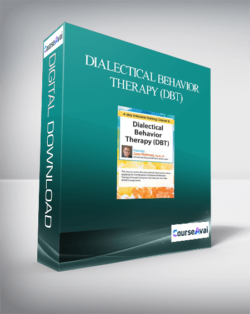 Dialectical Behavior Therapy (DBT): 4-day Intensive Certification Training Course (Digital Seminar)
₹21,912.00
Dialectical Behavior Therapy (DBT): 4-day Intensive Certification Training Course (Digital Seminar)
₹21,912.00
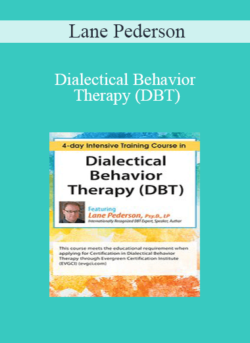 Lane Pederson – Dialectical Behavior Therapy (DBT): 4-day Intensive Certification Training Course
₹21,912.00
Lane Pederson – Dialectical Behavior Therapy (DBT): 4-day Intensive Certification Training Course
₹21,912.00
Rick Hanson – 4-Day: Positive Neuroplasticity Course with Rick Hanson, Ph.D.
₹21,912.00

